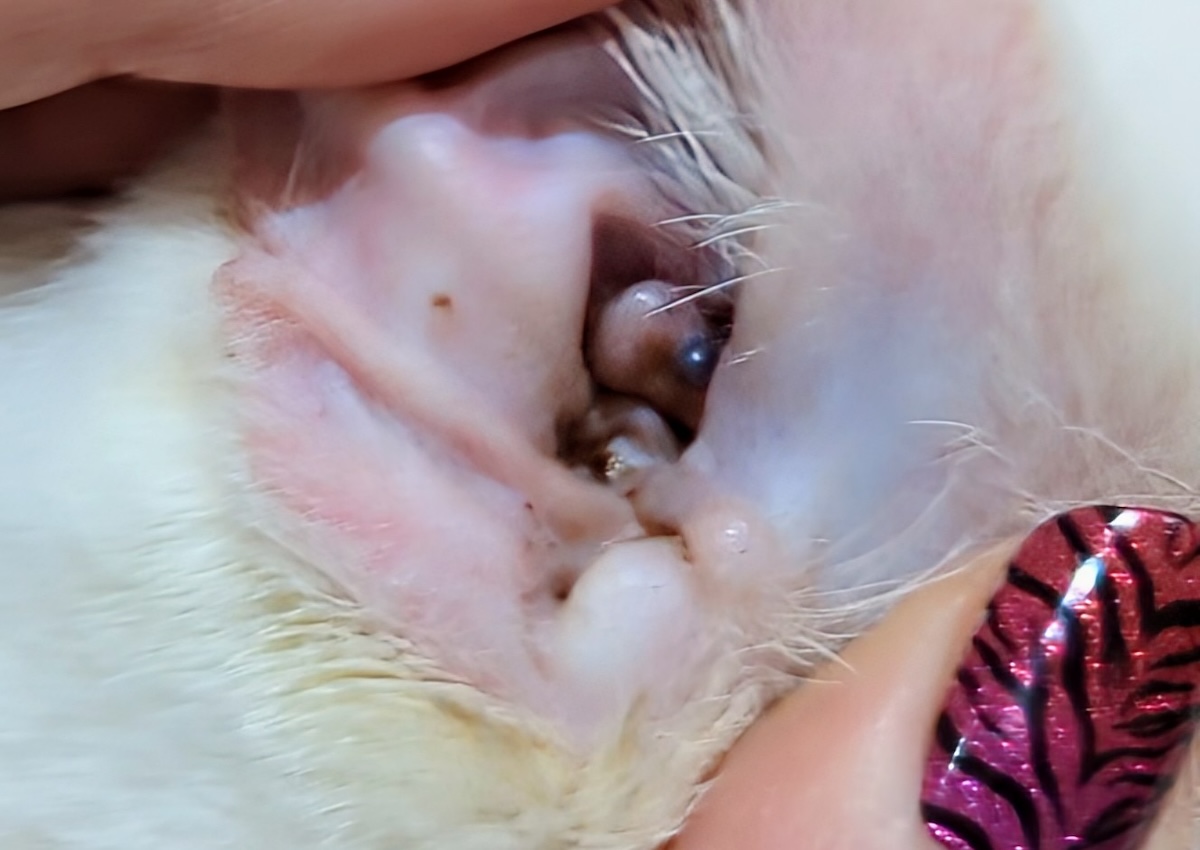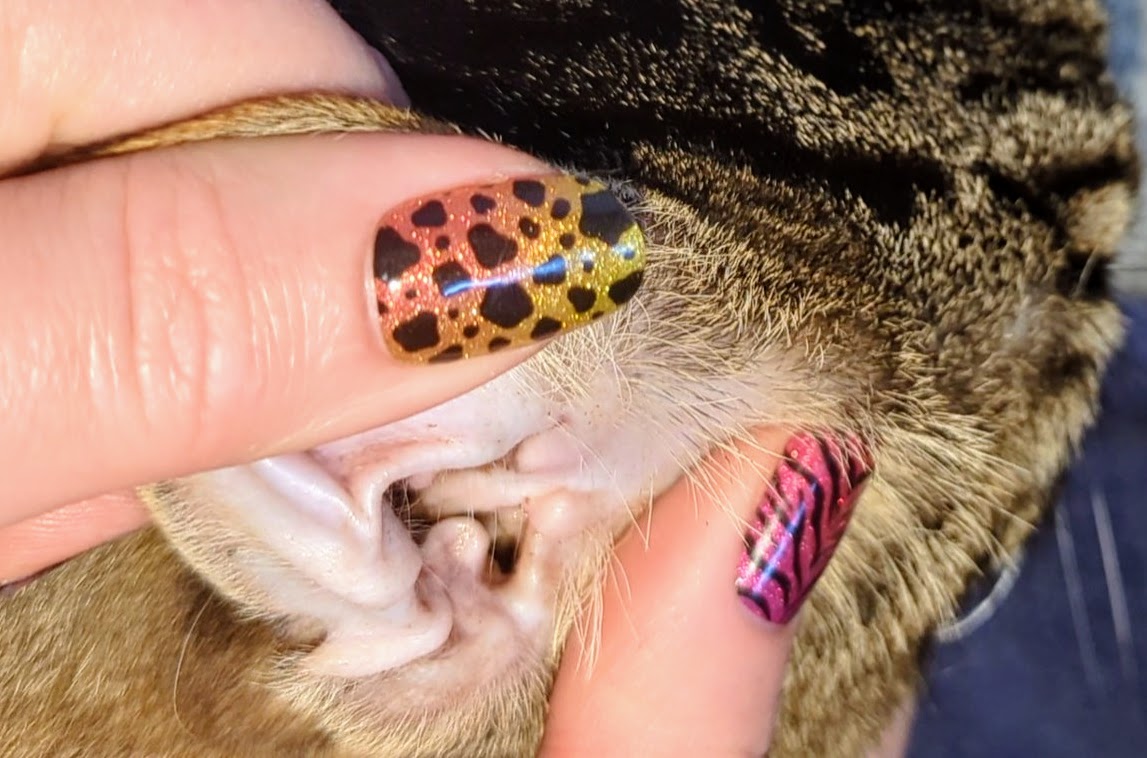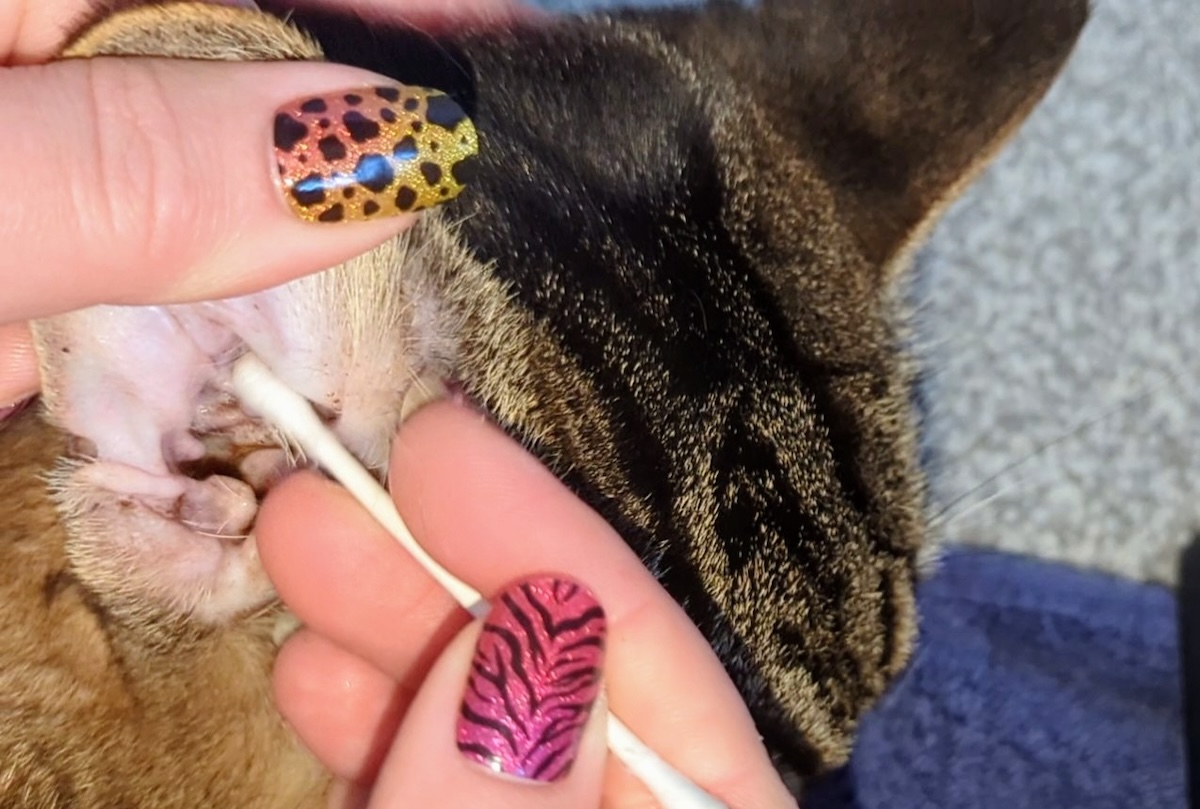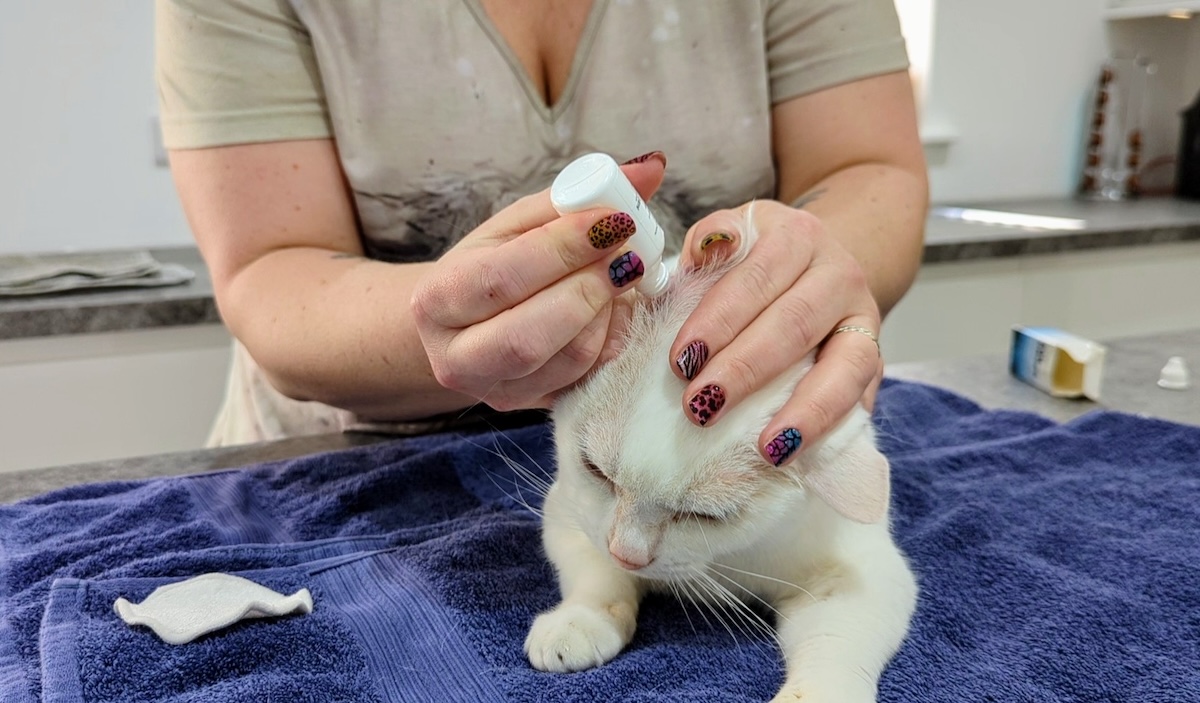Hi, I’m Dr. Karyn! Read my introduction to learn more about me and meet my five funny cats: Clutch, Cyril, Alex, Zelda, and Zazzles.
Fortunately for us, cats are pretty good at keeping themselves clean, rarely requiring any major intervention from their humans, aside from some brushing and the occasional nail clip. However, some cats suffer from waxy ears, or they may need to have their ears cleaned as part of treating an infection.
I’m lucky that only one of my cats, Clutch, needs regular aural attention. He has a few small polyps in the area outside his ear canals that make him prone to ear infections, but luckily don’t cause any other issues for him. He’s also a bit unusual for a cat in that he’s not as diligent about grooming himself as most other cats! Fortunately, he is very cooperative with my efforts to keep him clean and tidy, including cleaning his ears, and even giving him a bath!
So with her help, I’ll talk you through cleaning a cat’s ears, starting with why it might need to be done, and how to do it safely.
Do They Need to be Cleaned?
For the most part, you don’t need to worry about cleaning your cat’s ears, but if you notice that they look dirty, scratchy, smelly, or anything out of the ordinary, the first thing you need to do is make an appointment to your vet.
Although, like Clutch, some cats are prone to waxy or dirty ears, in most cases, if a cat’s ears need to be cleaned, there is a medical reason. Ear mites, ear infections, polyps, and even some types of cancer can result in discharge from the ears that may be creamy, crumbly, black, brown, or foul-smelling, and a variety of other problems require of different treatments. Part of that treatment may include cleaning the ears or applying ear drops, or your cat may just need regular cleaning.
The bottom line is that you should always seek vet advice before putting ANYTHING in your cat’s ears – the last thing you want to do is make anything worse.

How to Clean Your Cat’s Ears
This is something that will require at least some level of restraint, so I recommend checking out my article and video on how to safely restrain your cat. I’m really lucky because Clutch allows me to do most things with her with little fuss, but not all cats are totally compliant. It’s important to see what you’re doing, so you want to make sure you’re in a place and a position that allows you to check the ears, and if possible, have a second set of hands to help you.
Always make sure you have everything you need or may need before you start, because even the most tolerant cat will lose patience very quickly if you have to keep stopping and starting. Your equipment list should include:
Equipment:
- Ear cleaning solution and/or ear drops
- Cotton pads or cotton balls – reusable ones are fine
- Cotton buds
- A towel
- Treats
→ make sure you use an ear cleaner and ear drops prescribed or recommended by your veterinarian
→ if you have been advised to clean the ears before applying ear drops, it is a good idea to wait 10-15 minutes after cleaning before applying any medicated drops.
Step 1: Set a Calm Scene
Place a towel on the table or bench you will be working on, or on the floor if you prefer. This provides a nice non-slip surface and can be used to wrap your cat if necessary. Take your cat to your chosen place and give them a treat and excitement. If their ears don’t hurt, give them a little rub and scratch as a way to clean the ear.
Step 2: Know the Anatomy
Before you start poking, poking, or cleaning, take a good look at the ear and make sure you can identify the ear canal. Your vet can help you with this, and the photo below of Cyril’s ear shows the canal very clearly.

Step 3: Clean Out the Ear Canal
This is for cotton buds. Although you should NEVER insert cotton buds into the ear canal, they are perfect for getting wax out of the nooks and crannies formed by the cartilage surrounding the ear canal.

Step 4: Clean the Inside of the Ear Canal
If your cat is particularly sensitive or painful, or if your vet has advised you not to put any cleaning solution into the ear canal, a good option is to pour a generous amount of ear cleaner onto your cotton pad/ball, and place it on the surface. your finger to clean out as much of the ear canal as you can reach.
Because of the angle of the canal, you won’t hit the eardrum unless you start angling cotton buds into the ear.
Step 5: Apply the Drops or Cleaning Solution Directly to the Ear Canal
Do not put any solution in the ear canal unless your cat has been examined by a veterinarian.
Hold the pinna (ear flap) at the top of the head so you can see the ear canal. Insert the nozzle into the canal to apply the solution or drops as prescribed by your veterinarian. Hold your cat’s head and ears firmly to prevent them from shaking their head, which causes drops to fly out of the ear.

Firmly massage the cartilaginous base of the ear – most cats will like this step, and it helps the medicine or cleaning solution reach deeper into the ear canal. If you use an ear cleaner, use the cotton pad/ball to wipe away any discharge and solution around the ear canal. Repeat until you have no discharge out.

Step 6: Share as a Friend
Be sure to give your cat a treat, a treat, and an extra ear rub to make sure you end on a positive note.
Your cat will probably flap their ears and shake their head for a few hours after their ear is cleaned, but if it continues for more than 4-6 hours, a vet check is advisable. If your cat develops a headache that lasts more than 4-6 hours after cleaning/treatment, call your vet.
Reduce Inhibition = Reduce Stress
I find that cats are more likely to get stressed and fight back when we wrap them tightly or use excessive force to restrain them. If you can make ear cleaning a positive experience, there’s a good chance you’ll be able to clean your cat’s ears on your own, with just a few firm but gentle hands, keeping their stress levels in check. However, if your cat really doesn’t tolerate their ear hygiene, you may find that wrapping with a towel may be the safest way for you to proceed.
While not all cats are as relaxed as Clutch, in many cases, ear cleaning can be a therapeutic, beneficial, and enjoyable procedure that your cat may not only tolerate, but enjoy.
Join us next week when we take my cats on medicine!




